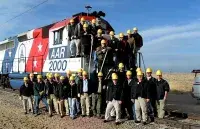 TSA Deputy Administrator Michael Miklos and Surface Operations Assistant Administrator Sonya Proctor meet with Amtrak security personnel in New York City on October 21, 2020. (Photo courtesy of TSA Surface Operations)
TSA Deputy Administrator Michael Miklos and Surface Operations Assistant Administrator Sonya Proctor meet with Amtrak security personnel in New York City on October 21, 2020. (Photo courtesy of TSA Surface Operations)
TSA is best known for keeping the nation’s air travelers safe, but the agency also plays a critical role in protecting the country’s massive surface transportation network.
The TSA Modernization Act of 2018 changed TSA’s approach to surface transportation security by reorganizing and consolidating surface operations responsibilities and functions. The Act streamlined how TSA engages with surface stakeholders and administers operational activities. On October 1, 2019, TSA established Surface Operations within its Security Operations, which is widely recognized for overseeing airport security checkpoint and baggage screening.
Recently celebrating the completion of its first year, Surface Operations is led by Assistant Administrator Sonya T. Proctor, who was promoted from the TSA Office of Policy, Plans and Engagement, Surface Policy. Proctor oversees personnel who support the surface security mission from the headquarters, regional and local field office levels.
Those Surface Operations teams are fully dedicated to the mission of building strong security partnerships with surface transportation owners and operators from the following modes of transportation: mass transit and passenger rail, highway and motor carrier, freight rail, maritime, and pipeline.
Surface Operations has five regional offices, each led by a security director and supported by a security inspector, executive assistant and three program analysts. Each region aligns with FEMA and serves a crucial role in supporting Surface Operations’ ability to carry out its mission and industry engagement strategies.
Senior Program Analyst Robert Jackson, whose region covers Chicago O’Hare International Airport, believes the reorganization and consolidation gives Surface Operations more stability. In 2010, he transitioned from the aviation/screening side of Compliance Inspections and became a surface transportation security inspector (TSI-S).
“During that time, the surface mode of Compliance was still young, and there were many changes and uncertainties that kept most of us on the edge of our seats and concerned about our future,” Jackson said. “We went through many changes during those early days of Surface including a couple of reorganizations. With the new Surface Operations, I am very optimistic and excited. This has renewed my passion toward surface transportation security. We now have new enforceable regulations and a packed toolbox of structured oversight programs.”
Because of the change, Lead TSI-S Joseph Larkin from the Pittsburgh Surface field office believes surface inspectors now have the resources and authority to more directly focus on surface-related security efforts and strengthen partnership opportunities across the surface transportation industry.
“Creating and maintaining partnerships with our stakeholders is critical in the success of keeping the transportation industry secure,” Larkin said. “We accomplish this by partnering with associations and through direct one-on-one interactions with individuals and through the many programs Surface Operations offers, including regulatory inspections and outreach efforts.”
As the regional security director for Region 1, Marisa Maola of New York said, “I couldn’t be more proud of the work accomplished in one year.” The security directors for all five regions developed a suite of surface transportation strategies to map out a comprehensive vision, mission and direction for the organization.
TSA surface inspectors have been around since 2005, and the agency currently has approximately 200 of them administering inspections, investigating alleged federal violations, conducting security assessments, facilitating exercises and making sure surface transportation system owners and operators comply with TSA-issued guidelines, standards and regulations.
“There are very few regulations in place for surface transportation,” said Maola, “and we rely genuinely on the outreach and voluntary surface activities that Surface Operations offers to our stakeholders.” Those events include roundtable discussions and exercises to assess regional security plans, policies and procedures in the event of a security threat.
Curt Secrest, who has been part of the TSA Surface Inspection program since its creation, added, “We now have an organizational structure and most of the personnel in place to support our stakeholders and enact programs, policies and procedures to guide us on our mission.”
Secrest works closely with each field office in his region and provides recommendations on all security and regulatory matters concerning freight rail, mass transit, maritime, and highway transportation.
Because surface transportation has several modes, Houston TSI-S Ryan Thomas said it takes “collaborative strategy to ensure their security.” Thomas believes it’s a great time to be a part of the Surface Operations family.
“Although this organization is a year old, the surface transportation security mission has existed for some time and is finally getting the recognition it deserves,” Thomas noted. “We have seen a lot of organizational changes over the years. While they can create administrative challenges, they have been for the betterment of TSA’s surface transportation role. What seemed like a secondary priority has been brought up to the front, and we’re just getting started.”


